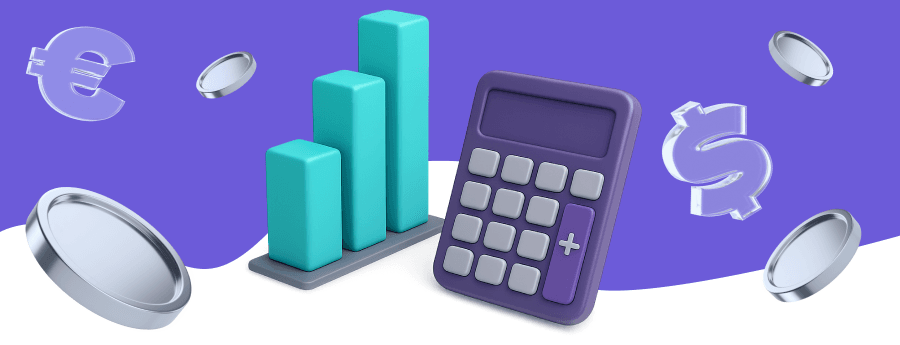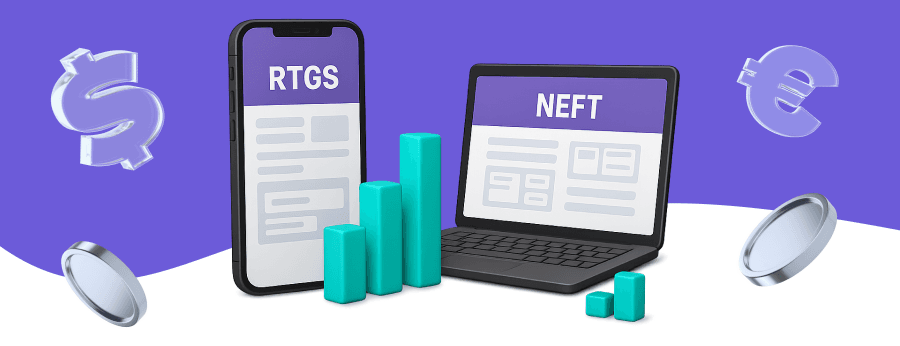Two main electronic payment systems — NEFT (National Electronic Funds Transfer) and RTGS (Real-Time Gross Settlement) — underpin India’s digital economy. Whether you're making a transfer of money from one to another bank account or handling high-value transactions, you need to know the differences between the two in order to pick the right type. Below, you’ll find the key differences between NEFT and RTGS to distinguish them clearly, how they work, how much time NEFT takes, and when to use each during the fund transfer.
Full Form of RTGS and NEFT
RTGS means Real-Time Gross Settlement, a system where fund transfers are processed in real time and on an individual basis without overlapping with other operations. It is mainly used for high-value transactions that need to be cleared immediately.

NEFT is an abbreviation for National Electronic Funds Transfer. NEFT transactions are made in batches at regular intervals of time throughout the day. It’s a convenient option for retail payments and suits for transferring money between bank accounts at different branches or banks.
Both are electronic payment systems run by the Reserve Bank of India which enable fund transfers from one bank account to another across the country.
For faster low-value payments, quite a number of customers also use IMPS (Immediate Payment Service), which is available 24/7 and provides fund transfer in real time, even on bank holidays. The difference between IMPS and NEFT lies in processing speed — IMPS is instant, while NEFT operates in scheduled batches.
NEFT and RTGS in Brief
National Electronic Funds Transfer (NEFT) is a centralized payment system managed by the Reserve Bank of India (RBI). It allows batch-based fund transfers between different banks which usually take up to 30 minutes. NEFT is perfect for both individuals and businesses that don’t need real-time settlement, but at the same time are looking for a cost-friendly way to move money.
Unlike NEFT, Real-Time Gross Settlement (RTGS) supports instant, high-value transfers, where each transaction is processed and settled on an individual basis in real time. RTGS enables transfer of funds on the same day and could be especially useful in scenarios involving large corporate payments or urgent settlements when the time is of the essence.
Key Differences Between NEFT and RTGS
- Although both NEFT and RTGS are supervised by the Reserve Bank of India (RBI), their purposes and modes of operation are different.
- Speed of Settlement: NEFT processes transactions in half-hourly batches, whereas RTGS settles payment on a continuous and real-time basis.
- Transaction Value: NEFT has no minimum limit and can be used to make transactions of any amount. However, NEFT transfer limits may be imposed by individual banks or online banking platforms. RTGS though is used for high-value operations beginning at ₹2,00,000.
- Processing System: NEFT is deferred net settlement (DNS), meaning payments are queued and settled in intervals. RTGS payments are settled individually and in real-time.
- Best Use Case: NEFT is a fine choice for low-to-medium value transactions like monthly salaries or vendor invoices, while RTGS is good for time-sensitive or large payments like a purchase of property or business transactions.
When to Use NEFT or RTGS?
Use NEFT when:
- The transaction amount is small or medium-sized
- The transaction is not time-sensitive
- You are paying bills, rent, wages or some kind of e-commerce purchases
- You are looking for a low-cost solution suitable for everyday bank transfers
Use RTGS when:
- You're sending ₹2,00,000 or more
- You need to make payment immediately
- It’s a business-to-business (B2B) or high-value personal payment
- You need real-time confirmation and enhanced security
Choosing the Right Payment System – NEFT or RTGS?
It’s worth noting three things when choosing the appropriate payment system: urgency, amount, and transaction context.
- If you have to send multiple small-to-medium value remittances, and can afford to wait for a few hours before the settlement, NEFT is a more practical and cost-effective option.
- For instant settlement of high-value transfers in a business or real estate transaction, RTGS is a better option thanks to its real-time processing and gross settlement.
To understand how long such transactions usually take and what can delay them, read our detailed guide on RTGS time for transfer.
A UTR number (Unique Transaction Reference) is a 22-character code generated during transfers via RTGS or NEFT, allowing you to track your money. You can use this reference to verify whether processing has been carried out or to ask questions to your bank.

Many businesses tend to use both — NEFT for regular payments and RTGS for large one-time transfers. For smaller amounts as well as for instant retail payments, one may use IMPS, which is a nice alternative way of payment available 24/7 via mobile and net banking services.
Online Payment Company #1
Online payment solutions for all types of businesses since 2019
Subscribe to stay updated
on industry news, insights, and exclusive offers


